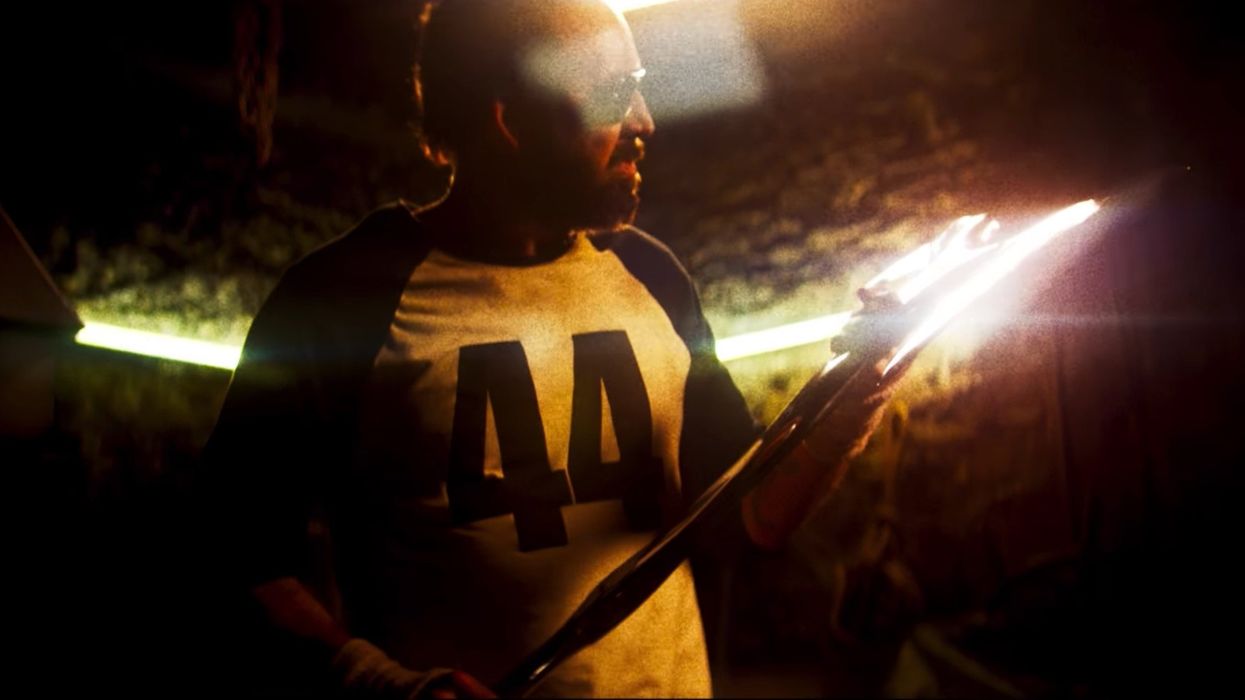Watch: The Early Work of 'Mandy' DP Benjamin Loeb
Bloody gore, lensed by a talented cinematographer, never looked so good as it does in 'Mandy.'

Some films defy description and others benefit from an exacting and studied scene-by-scene breakdown. And then there are films like Mandy, the gnarly, otherworldly feature from director Panos Cosmatos shot by Benjamin Loeb, that dare you to verbalize the film's impact into words. Allow me to play the fool for a moment.
Less a film about revenge than one about cartharsis—its brutality representing a purging of one's outer and inner demons—Mandy is a film which exists less on planet Earth than on the top shelf of a VHS rental store located in the darkest crevice of your brain (or in your local neighborhood mall's Hot Topic).
Red (Nicolas Cage) and Mandy (Andrea Riseborough) are husband and wife, living together in a house conveniently placed in one of the more desolate sections of the woods. He's a lumberjack and she works at a local convenience store, reading pulp novels that eerily resemble the wavelength of the movie she's in. They love each other, often sharing stories that philosophize on planetary functionalities and painful childhood memories.
One day, a cultish, Satanic-resembling group of hippies and rednecks driving through the woods come across Mandy, and the group's evil, long-haired leader Jeremiah (Linus Roache), becomes fixated on her. He believes that she must be captured and sacrificed to the Gods (or something like that), and so she is. Red, understandably grief-stricken, decides to take out his anger in some rather barbarous ways; forced to watch his wife go up in flames as thorn-like barbed wire keeps him stagnantly in place, Red transforms into a demented amalgamation of Jesus Christ and Ash from the Evil Dead series.
The film is set in the early 1980s but could honestly take place today—Red's well-worn shirt with the number "44" placed across the chest echoes memories of Barack Obama—our 44th President—and a reference to an evil bad guy being a "snowflake" echoes memories of our unfortunate 45th. When I questioned, after the film, why the story was set in this particular decade of Reaganism, I was informed that if it hadn't been, Red would've just used his cell phone to call the police for help. "No," I countered, "police certainly don't exist in the world of this film."
Not much resembling normality does, and the film has its own logic: leather-clad demons on motorbikes, summoned from the dark depths, show up throughout the film appearing more enthusiastically into BDSM than the Cenobites in Hellraiser. Whether we're presented with a character's flaccid penis or a commendably erect one resembling a long metallic sword, the film wears its grindhouse love on its blood-soaked sleeve.
The film looks equally slick and grungy, as if we were watching a 16mm print and DCP of the film simultaneously.
As the second half of the film evolves into a video game-like structure—Red takes on one "boss" after another, after another, etc.—everything matches up: Cage's performance is both humorous and melodramatically heartwrenching (a mourning-marathon in a brightly lit bathroom is Cage at his most perverse), and the film's red-covered, punk mise-en-scène is only further illuminated by literal fire that burns brightly throughout.
Cinematographer Benjamin Loeb takes great pride in getting to play in Cosmatos's charcoaled world, and in a film that incorporates crude animation and prosthetic makeup effects, Loeb's lighting knows when to use natural light and shadow play (the film's finale feels lit almost exclusively via a burning flame that's on the verge of dying). The DP also knows when to go full-force, as in the home invasion scene where nightmarish strobe lighting shows us glimpses of the horrors at play, or a subsequent "tightrope act" involving the seamless superimposition of one character's face onto another. Simply put, Mandy looks equally slick and grungy, as if we were watching a 16mm print and DCP of the film simultaneously.
Loeb has an extensive background, shooting a wide-range of commercials—for MLB, for one, and a wristwatch spot starring Hugh Jackman!—music videos—his work on Blue Hawaii's Do You Need Me? is a master class in ambient lighting projected off of our cell phone screens—and documentary and narrative feature work—Hello Destroyer premiered at the Toronto International Film Festival in 2016. We're highlighting some of that work below in addition to again giving a solid plug to Mandy, of which you can dive even deeper in to via our interview with the director out of the 2018 Sundance Film Festival.
For more work shot by Benjamin Loeb, be sure to check out the cinematographer's official website here. Have you seen Mandy yet? Let us know what you thought in the comments below.












